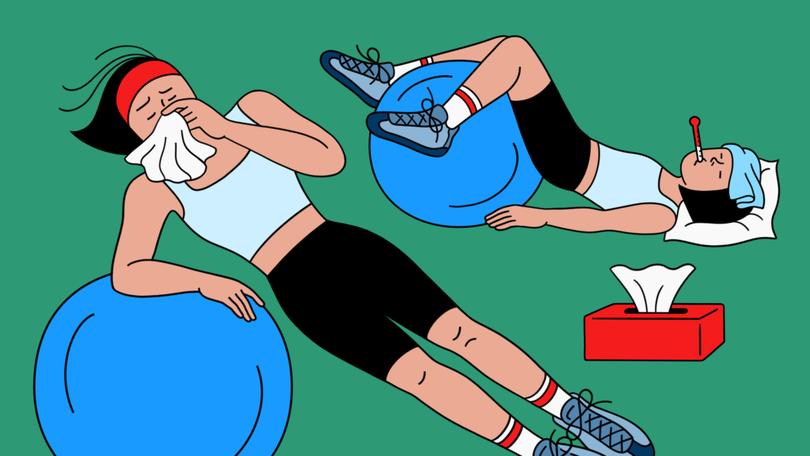THE NEW YORK TIMES: Is it safe to exercise when you’re sick?

It happens to all of us: Your alarm goes off for a morning workout and you roll over with a groan. You’re not just tired — your body feels off.
If you’re starting to get sick, is it better to rest or push through an illness to get to the gym? And how sick is too sick to exercise?
Look to your specific symptoms for answers, said Dr. Greg Summerville, a sports medicine physician at the University of North Carolina at Chapel Hill.
Sign up to The Nightly's newsletters.
Get the first look at the digital newspaper, curated daily stories and breaking headlines delivered to your inbox.
By continuing you agree to our Terms and Privacy Policy.“Your body is speaking to you,” he said. Your symptoms are there for a reason.
With fall virus season picking up, The New York Times asked doctors how to know when you should skip your workout and when it’s safe to get back to exercise.
Use your symptoms as a guide.
When you first feel an inkling of illness, Dr. Amy Comander, director of the lifestyle medicine program at Massachusetts General Hospital, recommends evaluating how your whole body feels, and doing a “neck check.” If your symptoms are above the neck — say, a runny nose, congestion or a sore throat — you are probably safe to work out as long as you feel up for it.
But if you are experiencing symptoms below the neck, such as muscle aches or an elevated heart rate, that is probably a sign that your body is working hard to fight off an infection, and exercising could set back your recovery time, she said.
If you have a fever of 100 degrees Fahrenheit or higher, Summerville said, that’s also a clear signal to rest, even if your symptoms are otherwise mild.
Doctors advise being especially careful if you are experiencing vomiting or diarrhea, which can be severely dehydrating. Comander recommends waiting at least 24 hours after you have recovered from a gastrointestinal illness before exercising. For flulike symptoms, including muscle aches, fatigue and joint pain, patients can return to exercise gradually when symptoms have resolved.
If you are recovering from a severe illness such as pneumonia, or if you were hospitalized, ask your doctor when it’s safe to exercise.
What if it’s COVID-19?
The guidance from the Centers for Disease Control and Prevention for returning to your normal activities after COVID is now similar to that for other respiratory illnesses, but it’s important to consider the severity of your case before exercising.
Comander pointed to the most recent guidelines from the American College of Cardiology: If you’re asymptomatic, according to those guidelines, you can try working out three days after you test positive. (Taking even a few days off can be helpful in case you develop symptoms later, Comander said.) But if you have any significant heart- or lung-related symptoms such as chest pressure or a persistent cough, wait until they resolve before trying to exercise.
The decision on when you go back to working out should primarily be based on how you feel, not necessarily on how you are testing or how long you have had COVID, said Dr. Tanya Melnik, co-director of the Adult Post-COVID Clinic at M Health Fairview in Minnesota. Individual responses to the infection can vary significantly, she added. For people who experience more fatigue during and after COVID, “patience becomes a really necessary virtue,” she said.
Once you feel up for more activity, Melnik recommends, make sure you can do basic chores without feeling wiped out. Try going up and down a flight of stairs, running errands or simply standing up for a few minutes. If any of those activities leave you exhausted, it’s probably too early to exercise. But if you are able to do routine tasks without experiencing fatigue or shortness of breath, it is safe to try low-intensity, short workouts, she said.
Build up the intensity and duration of your exercise gradually, Melnik said, “but not both at the same time.”
Start slow, and be patient.
Instead of going for a personal best once you’re feeling well enough to exercise again, focus on “completion days,” said Dr. Daniel Anderson, a cardiologist at Nebraska Medicine. Pay less attention to your running pace or how much weight you can lift and embrace the fact that you made it out the door.
And don’t be surprised if it takes a few weeks to get back to your usual exercise routine. “For every day you’re down and out, give yourself three to recover,” Anderson said, although your age and fitness level can affect your recovery time.
As you ramp back up, Anderson also recommends trying the talk test: If you can’t hold a conversation during your workout, you may need to dial it back.
“The last thing you want to do is to get in trouble by doing too much coming out of the chute,” he said. “Take it with caution, take it with ease.”
This article originally appeared in The New York Times.
© 2024 The New York Times Company
Originally published on The New York Times
